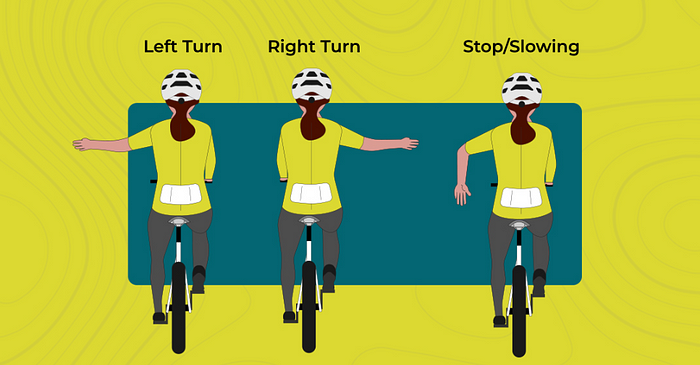
As an eco-friendly and healthy mode of transportation, cycling has gained popularity among more and more people. Ebike as a new way of cycling is also getting more and more popular. However, simultaneously, concerns about cycling safety have also attracted significant attention. Riding a bicycle or an ebike in busy city streets requires not only the use of proper safety gear and adherence to traffic rules but also the effective utilization of various safety signals for better communication with other road users. This article will introduce different safety signals commonly used in bicycle riding and their corresponding meanings, aiding cyclists in enjoying the thrill of riding while prioritizing safety.
1. Stop Gesture
The most common and crucial gesture is the one indicating a need to stop ahead. When planning to come to a halt, cyclists stretch out their arm with their palm facing downward at a right angle to the ground. This gesture alerts vehicles behind you to slow down and make a way in advance.
2. Right Turn Gesture
When intending to make a right turn, cyclists extend their arm to the right, with the palm facing downward in a horizontal position. This gesture conveys your turning intention to vehicles and pedestrians behind you, reducing the risk of potential collisions.
3. Left Turn Gesture
The left turn gesture is the opposite of the right turn signal. When planning a left turn, cyclists extend their arm to the left, palm facing downward and in a horizontal position. This signal informs traffic participants behind you about your impending left turn.
4. Stop and Wait Gesture
When waiting at a traffic light or intersection, cyclists can use an extended arm with the palm facing forward and perpendicular to the ground, indicating their intention to stop and wait. This gesture helps other road users understand your intentions, avoiding confusion and potential hazards.
5. Emergency Stop Gesture
For sudden emergency stops, cyclists can extend one arm backward, with the palm facing backward and perpendicular to the ground. This gesture signals vehicles behind you that you are making an abrupt stop, preventing rear-end collisions.
6. Warning Gesture
When you spot obstacles, hazards, or situations requiring attention ahead, you can raise your arm upward, palm open, and form a 90-degree angle with the ground. This gesture alerts others to be cautious about the situation ahead, minimizing the risk of accidents.
7. Riding in Parallel Gesture
When riding alongside other cyclists, you can extend one arm horizontally to the side, indicating your intention to ride in parallel. This gesture helps maintain a safe distance between you and your fellow riders.
8. Narrow Passage Ahead Gesture
When the road narrows ahead, you can extend your arm to one side, signaling that the passage ahead is becoming narrower. This gesture prompts vehicles behind you to slow down or yield, ensuring safe passage.
9. Backward Movement Gesture
In tight spaces or situations requiring backward movement, cyclists can extend their arm backward, with the palm facing outward and parallel to the ground. This gesture clearly communicates your intent to move backward, preventing collisions or confusion.
10. Thank You Gesture
Politeness and gratitude are important on the road. When a vehicle gives you the right of way or assists you, you can wave your hand backward to express thanks. This friendly gesture helps maintain traffic order and positive interpersonal relations.
By employing these safety gestures during cycling, riders can significantly enhance their safety and reduce potential risks. Whether indicating a stop, making a turn, warning of danger, or expressing gratitude, each gesture carries a specific meaning. Through these simple yet clear actions, cyclists can better communicate and coordinate with other road users, collectively contributing to a safer and more organized road environment.
With the introduction of these gestures, it is hoped that cyclists will be able to enjoy the excitement of bicycle riding while prioritizing safety. Additionally, they can become road guardians, working together to create a safer and more harmonious travel environment. Let’s pedal on, embracing the wind and using safety signals to protect ourselves and others on the road!

